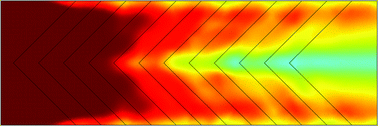A microfluidic device known to mix bulk solutions, the herringbone microchannel, was incorporated into a surface-binding assay to determine if the recirculation of solution altered the binding of a model protein (streptavidin) to the surface. Streptavidin solutions were pumped over surfaces functionalized with its ligand, biotin, and the binding of streptavidin to those surfaces was monitored using surface plasmon resonance imaging. Surface binding was compared between a straight microchannel and herringbone microchannels in which the chevrons were oriented with and against the flow direction. A 3-dimensional finite-element model of the surface binding reaction was developed for each of the geometries and showed strong qualitative agreement with the experimental results. Experimental and model results indicated that the forward and reverse herringbone microchannels substantially altered the distribution of protein binding (2-dimensional binding profile) as a function of time when compared to a straight microchannel. Over short distances (less than 1.5 mm) down the length of the microchannel, the model predicted no additional protein binding in the herringbone microchannel compared to the straight microchannel, consistent with previous findings in the literature.

You have access to this article
 Please wait while we load your content...
Something went wrong. Try again?
Please wait while we load your content...
Something went wrong. Try again?


 Please wait while we load your content...
Please wait while we load your content...